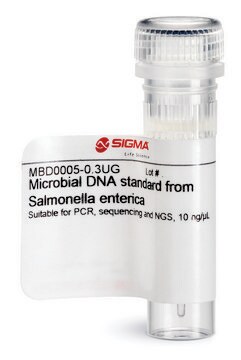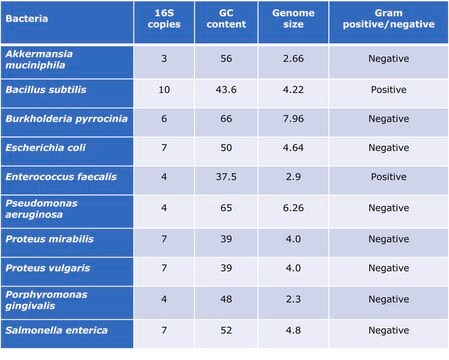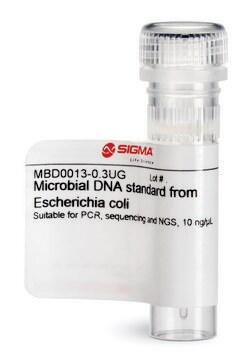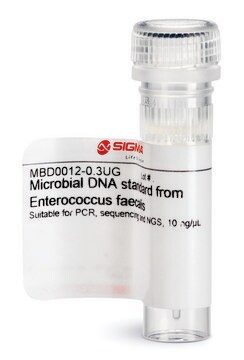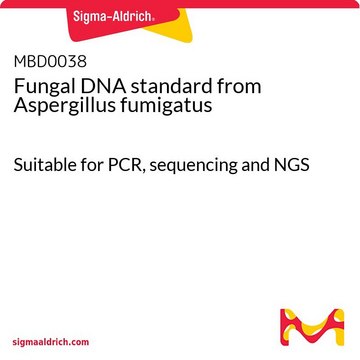MBD0023
Microbial DNA standard from Deinococcus radiodurans
Suitable for PCR, sequencing and NGS, 10 ng/μL
Anmeldenzur Ansicht organisationsspezifischer und vertraglich vereinbarter Preise
Alle Fotos(1)
About This Item
UNSPSC-Code:
41105500
NACRES:
NA.24
Empfohlene Produkte
Qualitätsniveau
Form
liquid
Konzentration
10 ng/μL
Methode(n)
DNA extraction: suitable
DNA sequencing: suitable
PCR: suitable
Versandbedingung
ambient
Lagertemp.
−20°C
Allgemeine Beschreibung
Standardization of sample analysis is currently needed in microbiome genomics research workflow. Lack of standardization can lead to biases and errors in common processes during sample preparation and analysis such as sample amplification, sequencing and bioinformatics analyses.1 Deinococcus rediodurans genomic DNA microbial standard can serve as standard for benchmarking the performance along the workflow of microbiomics or meta-genomics analyses and as a tool to increase reproducibility and allow comparison of results obtained by different labs.Since Deinococcus radiodurans is not a typical resident of the human microbiota it can serve as a spike-in standard in human microbiota genomics workflow analysis.
Deinococcus radiodurans is an extremophilic, heterotrophic, non-motile, non-spore-forming, aerobic tetracoccus bacterium. 2 The cell envelope of Deinococcus radiodurans stains as a gram-positive, but the two membranes that separated by a peptidoglycan layer, makes it more similar to typical gram-negative bacteria. 3 Deinococcus radiodurans is an extremophilic microorganism that can survive harsh conditions such as cold, high temperature, acid, alkali, resistance to desiccation, oxidative stress, ionizing radiation and ultraviolet radiation. 3 Mechanisms responsible for these extremophilic characteristics include: efficient repair of DNA damage 4, 5, Nucleotides Excision Repair (NER) 6, unique DNA mismatch repair (MMR) method 7 and efficient cellular mechanisms such as proteolytic protein for removal damaged and misfolded proteins, Nudix hydrolase 8 a broad-spectrum of transcription factor and a unique regulatory protein, which stimulates recA gene transcription after exposure to ionizing radiation 9.The large tolerance of the extremophile, Deinococcus radiodurans to the extraordinary conditions makes this bacterium as a tool for metabolic engineering 10.
Read here how to use our standards to ensure data integrity for your microbiome research.
Deinococcus radiodurans is an extremophilic, heterotrophic, non-motile, non-spore-forming, aerobic tetracoccus bacterium. 2 The cell envelope of Deinococcus radiodurans stains as a gram-positive, but the two membranes that separated by a peptidoglycan layer, makes it more similar to typical gram-negative bacteria. 3 Deinococcus radiodurans is an extremophilic microorganism that can survive harsh conditions such as cold, high temperature, acid, alkali, resistance to desiccation, oxidative stress, ionizing radiation and ultraviolet radiation. 3 Mechanisms responsible for these extremophilic characteristics include: efficient repair of DNA damage 4, 5, Nucleotides Excision Repair (NER) 6, unique DNA mismatch repair (MMR) method 7 and efficient cellular mechanisms such as proteolytic protein for removal damaged and misfolded proteins, Nudix hydrolase 8 a broad-spectrum of transcription factor and a unique regulatory protein, which stimulates recA gene transcription after exposure to ionizing radiation 9.The large tolerance of the extremophile, Deinococcus radiodurans to the extraordinary conditions makes this bacterium as a tool for metabolic engineering 10.
Read here how to use our standards to ensure data integrity for your microbiome research.
Anwendung
The genomic DNA is provided at ≥10 ng/μl concentration in TE buffer pH 8.0.It is recommended to avoid freeze thaw cycles of this product.
Eignung
PCR, sequencing, next generation sequencing
Physikalische Form
Liquid -The genomic DNA is provided at ≥10 ng/μl concentration in TE buffer pH 8.0
Lagerklassenschlüssel
12 - Non Combustible Liquids
WGK
WGK 1
Flammpunkt (°F)
Not applicable
Flammpunkt (°C)
Not applicable
Hier finden Sie alle aktuellen Versionen:
Analysenzertifikate (COA)
Lot/Batch Number
It looks like we've run into a problem, but you can still download Certificates of Analysis from our Dokumente section.
Wenn Sie Hilfe benötigen, wenden Sie sich bitte an Kundensupport
Besitzen Sie dieses Produkt bereits?
In der Dokumentenbibliothek finden Sie die Dokumentation zu den Produkten, die Sie kürzlich erworben haben.
Unser Team von Wissenschaftlern verfügt über Erfahrung in allen Forschungsbereichen einschließlich Life Science, Materialwissenschaften, chemischer Synthese, Chromatographie, Analytik und vielen mehr..
Setzen Sie sich mit dem technischen Dienst in Verbindung.

